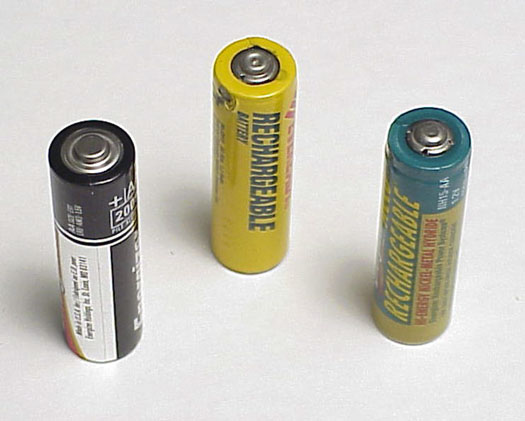When you're ready to make your robot move, it's time to consider the full battery of options. Size, strength, and lasting power are all factors to take into account when making your selection. Not to mention the price tag. Figure 1 displays an array of batteries for your consideration — including those so-called "terribly expensive" rechargeable types.

Figure 1: Battery options galore.
Those batteries you buy at the grocery store
Little pink bunnies marching around your TV screen aside, alkaline batteries have a shorter lifetime than a politician's promises. These batteries are everywhere, and everyone has a junk drawer full of them. Why do we buy these relatively short-lived beauties? The main reason is that they're initially cheaper than rechargeable types and don't require an expensive charger.
An alkaline battery will often last longer and have a higher voltage than a single cycle of a rechargeable battery, but after the charge is gone, that's it. For that reason, it's time to put the notion of alkaline batteries being a better value to sleep for good by realizing the benefits of rechargeable batteries.
Regardless of the advantages of rechargeable batteries on your pocketbook, alkaline batteries will work just fine in your robot.
NiCd batteries
A dying technology called NiCd, or nickel cadmium, offers rechargeable technology but has some downsides. They're bad news for landfills and also suffer from something called the memory effect. The memory effect causes a problem if you charge the battery before it's completely discharged. Essentially, the battery will charge only a percentage of its total capacity and eventually loses the capability to fully charge. Bottom line: don't even consider NiCd batteries for your robot.
NiMH batteries
A newer rechargeable battery technology is nickel metal hydride (NiMH). This type of battery has greater capacity than the older NiCd battery, and it doesn't suffer from memory effect.
The main disadvantages to NiMH batteries are that they're expensive and require a charger made specifically for them. But a careful look reveals the truth behind the cost-value tradeoff for this type of battery.
Consider this: Say your robot project requires eight AA batteries. This costs about $6 for nonrechargeable alkaline batteries or about $25 for NiMH rechargeable batteries, plus another $25 for a charger.
Rechargeables sound expensive, huh? Not so. In this scenario, if you replace the alkaline batteries ten times, you've spent $60. Buying NiMH batteries and the charger would cost you $50 — and your batteries would still have hundreds of recharge cycles left. After 100 cycles, alkaline cells would cost $600, and NiMH batteries would still have put you out only $50.
These calculations disregard the negligible cost of electricity for charging, but even so you're still way ahead with rechargeables.
Generally, the lighter the batteries, the less work your robot requires to move around and, therefore, the longer your battery life. NiCd batteries are usually the lightest but can be recharged only a limited number of times. NiMH batteries are heavier and can be charged many times. You can tell how much power a battery will supply by their amp-hour (Ah) rating. For example, a 7Ah battery can supply 1 amp for 7 hours or 7 amps for 1 hour or 28 amps for 15 minutes.
dummies
Source:http://www.dummies.com/how-to/content/juicing-up-your-robot-with-batteries.html
No comments:
Post a Comment